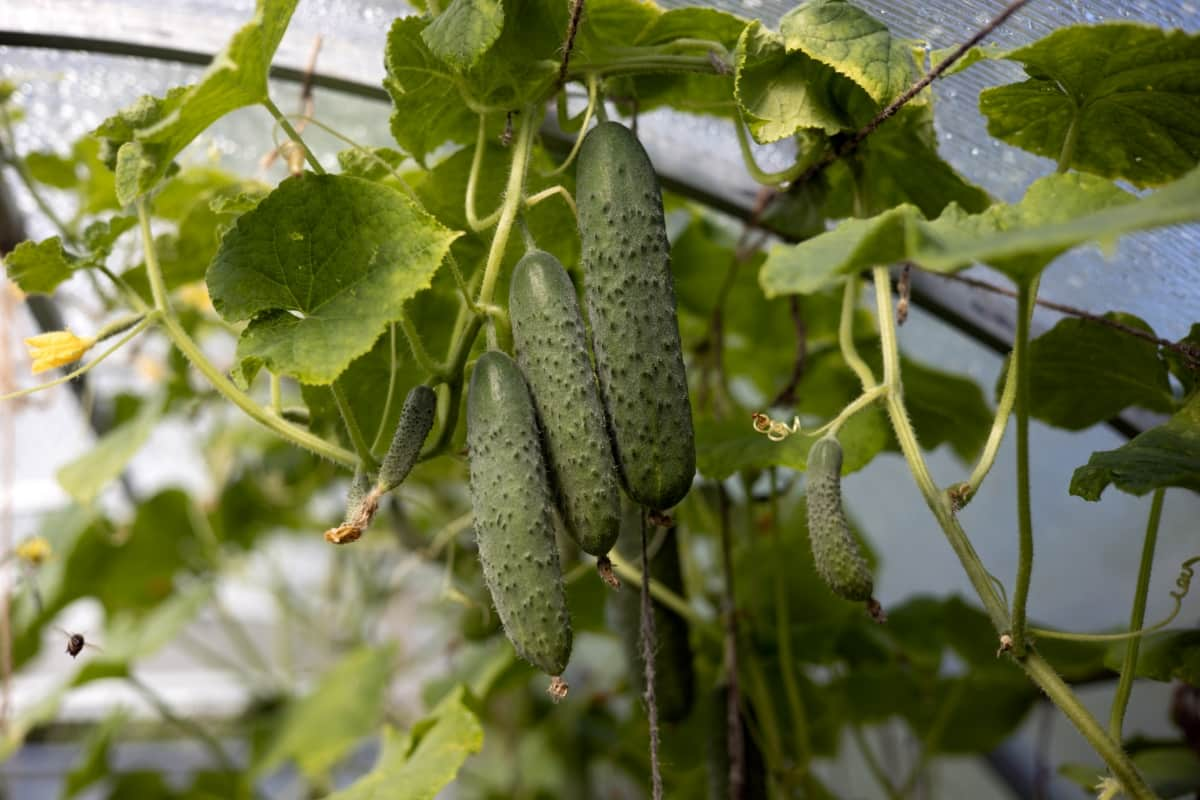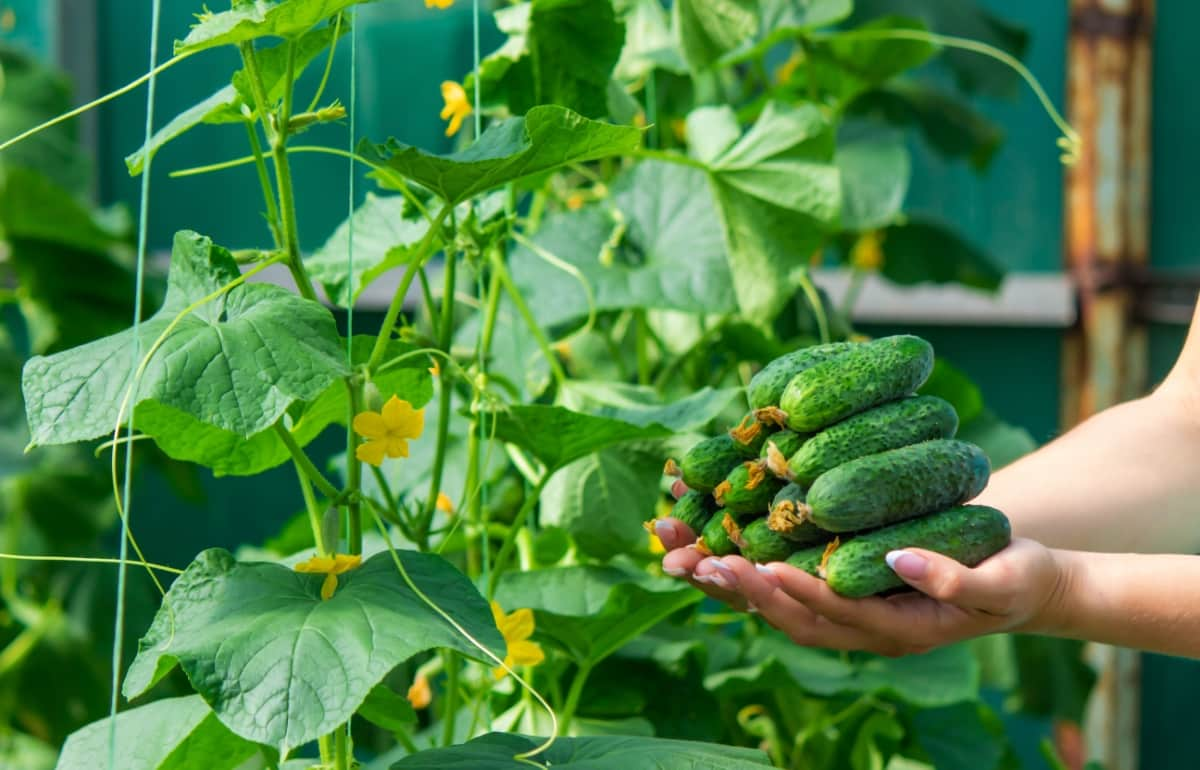Growing cucumbers in aquaponics can be a rewarding and efficient way to cultivate this popular vegetable. Aquaponics combines aquaculture (raising fish) with hydroponics (growing plants without soil) in a symbiotic environment. The fish waste supplies essential nutrients for the cucumber plants, while the plants help filter and purify the water for the fish. Here is how to grow cucumbers in aquaponics.

Growing Cucumbers in Aquaponics
Selecting the Right Aquaponic System for Cucumber Cultivation
Choosing the ideal aquaponic system for cucumber cultivation involves considering the specific needs of the crop and the available resources. For cucumbers, a media-filled bed or nutrient film technique (NFT) system tends to work well, providing adequate support for the plants and allowing their roots to access nutrient-rich water.
Additionally, a system with sufficient water flow and aeration is crucial to ensure optimal nutrient distribution and oxygenation. The scale of cultivation and space constraints should determine the size of the system. It’s essential to maintain a proper balance between fish stocking density and plant growth to avoid nutrient imbalances.
Choosing the Best Varieties of Cucumbers for Aquaponic Farming
“Marketmore” and “Straight Eight” are excellent choices due to their high yields, disease resistance, and adaptability to aquaponic systems. These cucumbers thrive in the balanced, nutrient-rich environment created by aquaponics, displaying vigorous growth and producing quality fruits. “Burpless” varieties, like “Burpless Tasty Green” or “Burpless Bush,” are preferred for their mild flavor and reduced bitterness. Opt for parthenocarpic varieties, such as “Picolino” or “Eversweet,” which don’t require pollination, ensuring consistent fruiting in the absence of bees.
Essential Water Quality Parameters for Cucumber Growth in Aquaponics
Essential parameters include pH levels, ideally between 6.0 and 6.5, ensuring proper nutrient availability. Ammonia and nitrite levels need to be monitored closely, as high concentrations can be harmful to cucumber plants. Temperature is vital, with an optimal range of 24-29°C for cucumber growth.
In case you missed it: How to Grow Cucurbits on Aeroponic Towers: Saving Space with Vertical Tower Garden

Dissolved oxygen levels need to be maintained above 5 mg/L to support root health. Also, EC (electrical conductivity) or TDS (total dissolved solids) should be monitored to ensure an appropriate nutrient balance. Regular testing and adjustments of these parameters will promote a thriving aquaponic system, fostering optimal cucumber growth.
Providing Essential Nutrients for Aquaponic Cucumbers
In aquaponics, cucumbers require essential nutrients for optimal growth. Maintain water pH between 6.0-6.5 and provide nitrogen, phosphorus, and potassium through fish waste. Supplement with iron, calcium, and magnesium for robust development. Utilize a balanced aquaponic fish feed to ensure proper nutrient cycling. Monitor ammonia and nitrate levels regularly, aiming for an ammonia concentration below 0.5 ppm and nitrate levels between 20-50 ppm.
Lighting Requirements for Growing Cucumbers in an Aquaponic System
For optimal cucumber growth in an aquaponic system, provide at least 12-16 hours of light daily, utilizing a full-spectrum LED or high-intensity discharge (HID) grow light. Ensure a light intensity of 200-400 micromoles/m²/s at the canopy level. Maintain a consistent light schedule to promote photosynthesis and flowering. Adjust the light distance to prevent heat stress or shading. Blue spectrum light aids in vegetative growth, while red spectrum promotes flowering and fruiting. Regularly monitor and adjust lighting conditions based on plant development.
Temperature and Climate Control for Optimal Cucumber Growth
Maintain daytime temperatures around 24°C and nighttime temperatures slightly lower. Humidity levels of 60-70% during the day and 80% at night foster optimal growth. Adequate ventilation is important to prevent heat buildup, as high temperatures can adversely affect pollination and fruit development. Provide consistent lighting, ideally 12-16 hours daily. In instances of insufficient natural light, supplement with artificial lighting. Well-draining soil with a pH of 6-6.5 supports cucumber development.
In case you missed it: How to Prevent Cucumber Fruit Rot Naturally: How to Control with Natural and Organic Treatment

Implement a drip irrigation system to ensure soil moisture remains consistent. Controlling humidity is equally vital; cucumbers prefer a relative humidity level between 60% and 70%. This helps prevent fungal diseases and ensures proper transpiration. Implementing a drip irrigation system and mulching helps maintain soil moisture levels, promoting steady growth. Regular monitoring of environmental conditions, coupled with adjustments as needed, ensures a conducive climate for optimal cucumber development and a bountiful harvest.
Planting and Spacing: Best Practices for Cucumbers in Aquaponics
Begin by selecting a dwarf or bush variety suitable for limited space. Use a well-aerated growing medium and consider starting seeds in nursery trays before transplanting. Maintain water pH between 6.0 and 6.5 and nutrient levels for robust growth. When planting, space cucumber seedlings approximately 12-18 inches apart to ensure good air circulation and sunlight exposure.
Employ vertical growing methods, such as trellising, to maximize space efficiency. Regularly monitor water quality and prune excess foliage to enhance nutrient uptake. These best practices promote a thriving cucumber crop in aquaponic systems, combining hydroponic efficiency with the benefits of aquaculture.
Maintenance and Care
- Water Quality: Ensure optimal water pH levels between 6.0 and 6.5 and maintain proper temperature (24-29°C).
- Nutrient Balance: Monitor nutrient levels regularly, adjusting to meet cucumber requirements. Nitrate and potassium are crucial.
- Lighting: Provide 12-16 hours of light daily using high-quality LED grow lights.
- Spacing: Plant cucumbers with a spacing of 12-18 inches to facilitate air circulation and prevent diseases.
- Pruning: Regularly prune excessive foliage to enhance air circulation and light penetration.
- Pollination: Assist pollination by gently shaking plants or introducing pollinators, as cucumbers require cross-pollination.
- Disease Prevention: Implement preventive measures against common diseases like powdery mildew, using organic fungicides if needed.
- Harvesting: Harvest your cucumbers when they reach the desired size to encourage continuous fruiting.
- Fish Health: Maintain a healthy fish population to provide nutrient-rich water for plants.
- System Check: Regularly inspect and maintain aquaponics system components to ensure proper functioning.
When and How to Harvest Cucumbers in Aquaponics
Harvest cucumbers in aquaponics when they reach a length of 6-8 inches, typically 50-70 days after planting. Regular monitoring is crucial as overripe cucumbers may hinder new growth. Use clean, sharp scissors to cut the fruit, leaving a small stem intact. Harvesting should be done in the morning when the plants are turgid, ensuring optimal flavor and texture. Gently twist the cucumber before cutting to avoid damage. Harvesting consistently encourages continuous fruit production in the aquaponics system.
In case you missed it: How to Grow Hydroponic Cucumber: A Step-by-Step Guide

Conclusion
Growing cucumbers in aquaponics involves a careful balance of fish and plant needs. By maintaining a well-functioning aquaponics system, selecting the right cucumber variety, and paying attention to water quality, nutrients, and environmental conditions, you can enjoy a bountiful harvest of fresh cucumbers. Regular monitoring, adaptability, and a proactive approach to any issues that may arise are key to a successful aquaponics cucumber cultivation venture. Happy growing!
- Feed Your Flock for Less: Top 10 Tips to Save on Chicken Feed
- Ultimate Guide to Ossabaw Island Hog: Breeding, Raising, Diet, and Care
- Hatching Answers: The Top 10 Reasons Your Chickens Aren’t Laying Eggs
- Eggs and Economics: Breaking Down the Cost of Raising Backyard Chickens
- Defend Your Greens: Proven Methods to Keep Iguanas Out of Your Garden
- Ultimate Guide to Cinnamon Queen Chicken: A Comprehensive Guide for Beginners
- Ultimate Guide to California Tan Chicken: Breeding, Raising, Diet, Egg-Production and Care
- Ultimate Guide to Marsh Daisy Chicken: Breeding, Raising, Diet, and Care
- 10 Types of Chicken Farming Businesses You Can Start for Profits